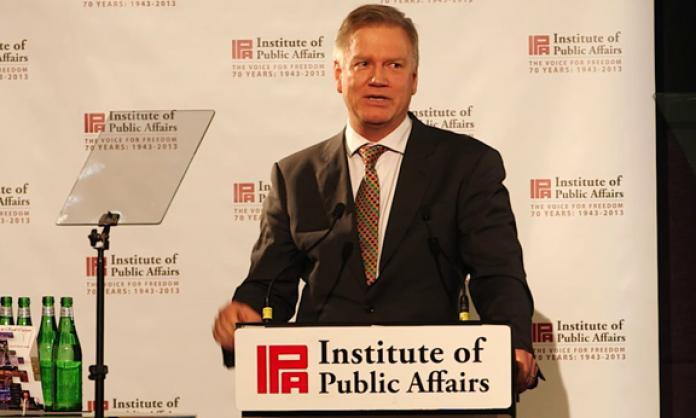1943. The Victorian capitalist class is in a state of panic. The Chamber of Manufactures creates an employers’ organisation to rescue private enterprise from the political abyss.
Seventy-five years later, the Institute of Public Affairs has become one of the most influential think tanks in the country.
Boasting 4,831 financial members and $6.1 million in donations last year, the modern IPA includes in its ranks several members of parliament, big capitalists, high-ranking public servants, university vice-chancellors and prominent journalists.
Its youth wing, Generation Liberty, claims a membership of more than 1,000. Its representatives can be found on almost all media outlets, from the “quality” to the gutter press. Most importantly, the IPA’s hard right politics have become mainstream: private enterprise and the market rule.
In 1943, it was a different story. Far-reaching state control to aid the war effort had, in the eyes of the Victorian manufacturers and IPA founders, “placed the Labor Party in a position where it is able to regulate and control every phase of business”. The public was restive, having made enormous wartime sacrifices. And memories of the Great Depression were still raw.
“One has only to sense the atmosphere in the streets and factories, to turn over the pages of the newspapers and periodicals … to listen to the talk which surrounds one … to realise that … ‘Humanity has struck its tents and is on the march’”, wrote Australian Paper Manufacturers boss, Chamber member and IPA founder Herbert Gepp.
The bosses believed that the credibility of private enterprise urgently needed to be restored. They could not afford to let the Labor Party and the unions entrench their domination. Intervention was vital.
Although ostensibly aloof from party politics, the newly formed IPA provided badly needed direction to the crisis-ridden conservative forces of the 1940s. Its pamphlet Looking Forward was influential at the founding conference of the Liberal Party in 1945, Robert Menzies describing it as “the finest statement of basic political and academic problems made in Australia for many years”.
The IPA did not leave it to the Liberal Party to strike back against Labor. Historian Norman Abjorensen describes how, in the 1949 election, the IPA was responsible for “a stream of propaganda that sought, successfully, to discredit Australia’s very moderate Labor Party as a socialist tiger waiting to pounce once the war had ended”.
Despite this success, more than 20 years of Liberal Party rule from 1949 created difficulties for the IPA. With Labor out of power, its constituency was harder to rouse. And its anti-immigration stance and small government, anti-inflation economic ideas were at odds with the Keynesian economic consensus of the time.
It wasn’t until the 1970s that the IPA emerged from the wilderness. This was due to two main factors. One was the advent of neoliberalism, which gave its free market economic theories a new legitimacy. The other was the social movements of the 1960s and 1970s, and the high level of working class organisation and activity, against which the IPA could help to cohere a reactionary backlash.
The backlash involved the IPA playing a prominent part in the “culture wars”. Through its publication, the IPA Review, it took up cultural questions, largely involving a defence of Western “civilisation” from any criticism.
It also gave political and economic support to those looking to discredit the Royal Commission into Aboriginal Deaths in Custody, attacked multiculturalism, promoted Christianity and opposed environmentalism.
This crusade has its echo today in the IPA’s campaign to scrap Section 18c of the Racial Discrimination Act, a campaign to legitimise bigotry and push back against the legacy of successful social justice struggles of the past.
The economic principles advocated by the IPA have brought it the most notoriety. These include scrapping almost all taxes on and government regulation of businesses, opposing any government-funded competition to private enterprise – including in media, education, transport and infrastructure – and drastically deregulating industrial relations to weaken unions and give bosses a freer hand.
In this area, the IPA has arguably enjoyed the most success. In the 1990s, the organisation was behind “Project Victoria”, the comprehensive plan for the neoliberal restructuring of the state’s economy implemented by the Kennett Liberal government.
The plan led to thousands losing their jobs, the privatisation of electricity provision, public transport and infrastructure – with skyrocketing costs to consumers – 350 school closures and the gutting of workers’ compensation. It starkly highlighted the human cost of the IPA’s agenda.
The panicked Victorian manufacturers who established the IPA in the 1940s would not easily recognise the organisation today, or the society it aims to influence.
Employers today have little cause for concern about their power being challenged by Labor or combative unions. Their profit making is everywhere assumed to be a social good and a measure of the economy’s health. And while corporate tax rates sat at around 50 percent for much of the Menzies era, today they are nearly half that and well on the way to the modern IPA’s preferred 10 percent.
IPA members, supporters and ex-officials occupy important seats of power. The highest ranking public servant in the country, public service commissioner John Lloyd, is a former IPA director, while at least four former IPA officials now hold parliamentary seats. Communications minister Mitch Fifield is a prominent IPA supporter, his portfolio of great assistance in the IPA’s long-running campaign to abolish the ABC and deregulate the media.
Rupert Murdoch, Gina Rinehart and numerous major corporations all provide generous financial and political backing.
Far from being a shout from the margins, today the IPA’s belligerent free market fundamentalism and hostility to any form of social justice enjoys substantial institutional support. All it lacks is a popular mandate.











